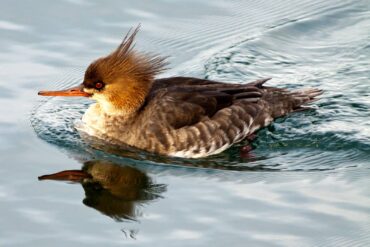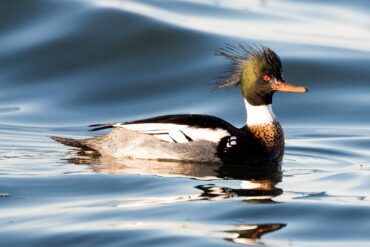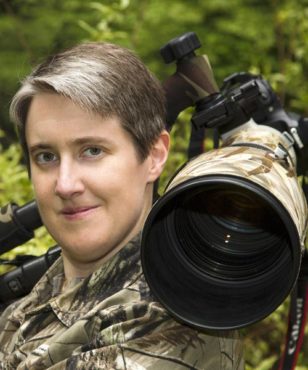
Birds come in all shapes and sizes, with adaptations specific to the habitats in which they live. Some birds reside in forests, while others are from the desert. Many wade along the water’s edge and others prefer to go swimming.
Among those who make their living in the water are geese, swans, ducks, cormorants, alcids, loons and grebes. Many can be found in either freshwater or saltwater, including numerous species of ducks.
All ducks fall into one of two categories: diving ducks, which forage while swimming underwater; and dabbling ducks, which feed near the surface. From late fall to early spring, West Sound’s waterways are home to an array of both diving and dabbling ducks, many of which breed in the Arctic.
A few of the diving ducks that frequent local waters are the three members of the merganser family: red-breasted, common and hooded mergansers. The red-breasted merganser is a common local winter resident with a preference for saltwater bays.
Mergansers are known for their wild hairstyles, but if ducks have crazy-hair contests, the red-breasted merganser would be sure to win. Of course, what appears to be punk-rocker hair is actually a double-pointed crest of shaggy feathers.
Males are unmistakable with a glossy, dark-green head; white collar; and rusty, black-spotted breast. Females have an orange-brown head and gray tones on the breast and sides. Both sexes have black-and-white wing patterns, red eyes and orange legs and feet. It takes two years to acquire full breeding plumage.

A trademark feature of the red-breasted merganser is the thin, red-orange serrated bill that it uses to tightly grasp fish, crustaceans and worms that it finds during shallow foraging dives. It carries the meal safely secured in its bill to the surface for consumption.
Red-breasted mergansers are sometimes seen “snorkeling,” as they search for prey with their heads partially submerged.
In order to thrive, a red-breasted merganser must eat 15-20 small fish a day. Because most attempts are unsuccessful, it may dive 300 times a day, foraging for up to five hours, to find enough food. That’s an average of a dive a minute.
Red-breasted mergansers sometimes work together in small “cooperative herding flocks” to force schools of minnows into a confined space, which allows for easy capture. They do not form rafts of hundreds of individuals like some ducks but prefer small groups of up to 10 companions.
Of the three merganser species, the red-breasted merganser breeds the farthest north and winters the farthest south. In order to make such annual journeys, it helps to be one of the fastest-flying ducks, capable of cruising at speeds of up to 81 mph. To get airborne, it must get a running start on the water.
Red-breasted mergansers winter along the Pacific and Atlantic coasts, traveling as far south as Baja (California), Texas and Florida. They arrive in West Sound’s saltwater bays by midfall. By midspring, they are heading north to their breeding grounds, the tundra and boreal forests of northern and southeastern Canada and Alaska.
Courtship displays involve multiple males “curtsying” to pursue a single female. A male raises his crest, stretches out his neck, points his bill skyward, then plunges his breast into the water, which forces his rear upward. In response, the female jabs at him with her bill.
The male may also shake his head back and forth to grab the attention of a female. If his efforts are successful, the female raises and lowers her head in a bobbing motion and the pair forms a monogamous bond for the season.
Red-breasted mergansers are awkward on land with legs set on the posterior, which they use for propulsion while diving. Thus, they are always close to water. Preferred nesting sites are spots on the ground, with sheltering vegetation near a lake, wetland or bay.
Red-breasted mergansers are late-season breeders, whose young typically don’t fledge until September. The female lays seven to 10 eggs and is solely responsible for incubation and care of the young, which hatch after about a month. Within a day of hatching, the young follow the female to water, where they are able to feed themselves.
Where breeding populations are dense, multiple broods may join together in a “creche” under the watchful care of two or more females. After a few weeks, the females abandon the young, who can’t fly until they are 2 months old.
Overall numbers appear to be stable. As with all marine birds, red-breasted mergansers rely on undisturbed nesting areas and healthy, unpolluted waters with an abundance of food.
Birdwatching offers a break from the stresses of life. With their wild hairdos, red-breasted mergansers are a treat on an otherwise dreary day. So grab the binoculars and head to the nearest bay. Look for the punk-rocker duck.





























